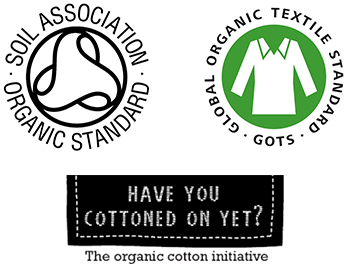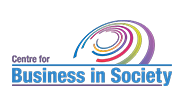 Just a few of the labels on offer
Shoppers face many hurdles when trying to shop for sustainable clothes. Clothes are what we term ‘credence’ products; in other words, consumers can’t tell whether a T-shirt is ethical just by looking at it. So, shoppers rely on many different cues to take the hassle out of their decision making. Social labelling is a signpost intended to help time-poor shoppers make quick and responsible choices. Social labelling or ‘eco’-labelling on clothing should reassure us about the back story of the item, for example, were the garment workers paid fair wages; was any environmental harm caused by the processing of the textiles; was child labour used to harvest the cotton? Social labelling should help ethical shoppers, but our research into consumer attitudes towards social labelling suggests that people often feel confused rather than informed when faced with what is often well intentioned garment labelling.
Just a few of the labels on offer
Shoppers face many hurdles when trying to shop for sustainable clothes. Clothes are what we term ‘credence’ products; in other words, consumers can’t tell whether a T-shirt is ethical just by looking at it. So, shoppers rely on many different cues to take the hassle out of their decision making. Social labelling is a signpost intended to help time-poor shoppers make quick and responsible choices. Social labelling or ‘eco’-labelling on clothing should reassure us about the back story of the item, for example, were the garment workers paid fair wages; was any environmental harm caused by the processing of the textiles; was child labour used to harvest the cotton? Social labelling should help ethical shoppers, but our research into consumer attitudes towards social labelling suggests that people often feel confused rather than informed when faced with what is often well intentioned garment labelling.
Part of the problem is the proliferation of social and eco-labels people encounter when they shop. The Eco Label Index lists 460 eco-labels in 197 countries, and 25 industry sectors. There are 108 labels related to textiles, and within that 8 related to just cotton, and that is before we consider specific categories such as ‘organic’. This is then made worse because each label can represent the same issues (no child labour), or different issues (no pesticides; fair wages; low carbon; recycled), but there is little guidance to help shoppers navigate a ‘best’ purchase choice. There is not a single, international, all encompassing ‘omni-label’ that covers everything, so – is it better to choose recycled materials or support fair wages when buying that T-shirt? H&M offer organic leather, hemp, silk, cotton and linen but also garments made from recycled polyester and polyamide and recycled wool. How does the everyday shopper determine which choice from these multitude of alternatives is most responsible? Even for consumers with reasonable levels of ethical literacy these variations create barriers to understanding and undermine choice confidence.
Shoppers also need to be reassured that a label does what it says, which means they have to know they can trust the governance mechanisms that regulate social/eco-labelling. This too is a potential responsible choice barrier, as each social label is monitored by different organisations. Some are checked by independent, third party organisations, such as Solidaridad or WWF, whereas others are label systems that are internally monitored by individual companies or industries. But how do consumers tell the difference when standing in-store? It means they have to work out whether they can best trust H&M ‘Conscious’ clothing made from organic cotton and signposted in-store by their Conscious green hang tag, as much as they can trust the Soil Association organic clothing label attached to their ASOS T-shirt. They might also find the Soil Association label lined up alongside the ‘Cottoned On’ label, and even the GOTS label, organisations which all work in partnership.
The problem is many consumers just give up when faced with increasing choice complexity in clothes shopping. So what could be done to help? Label ‘hyper segmentation’ needs to be curtailed; simplifying and rationalizing social labels is one solution where policy makers and business can help to aggregate rather than segregate the multiple areas of focus. Firms could choice edit the clothing they offer (much like the successful model that retailers Aldi and Lidl have pioneered) to reduce choice complexity and overload. Consumers don’t necessarily dislike less choice, and doing so might counteract some of the negative reasoning shoppers use to discount ethical alternatives and simplify decision making. Clothing retailers would also potentially experience a strategic benefit in communicating more extensive information through clearer labelling to allow consumers to understand how their purchases achieve real benefits in addressing the harms caused by the social, environmental and economic impacts of business. Enforcing standardized labelling across the textile and clothing sector might also generate a deeper understanding and greater amount of public awareness of responsible business and consumption than seems to currently exist.

The Life Story of your T-shirt
This blog was written as part of an online event run by The Institute for Social Marketing as part of the Festival of Social Science week (7th-14th November 2015).
Visit our event hub to learn more about how t-shirts are made, make decisions about sustainability and share the story of your own favourite t-shirt.

Rate and Review
Rate this article
Review this article
Log into OpenLearn to leave reviews and join in the conversation.
Article reviews